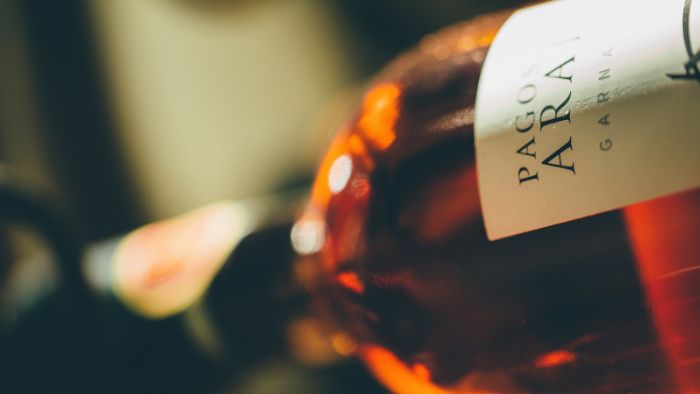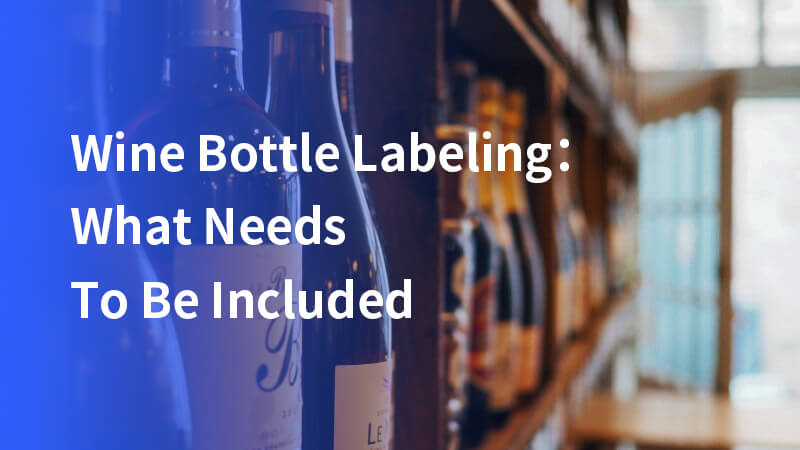Wine bottle labeling can be as intricate as the contents inside their containers. In addition to looking good, these labels must provide a lot of information for both intrigued customers and government entities. There is a lot to know about a bottle of wine, and it’s the label’s job to communicate that to the consumer.
As we recently discussed, the use of “wine labels” dates all the way back to ancient Egypt, with seals and etchings put in place to improve trade. Over centuries, the practice has evolved a great deal. Now there are federal rules and regulations to obey. Some information is mandatory, and some are nice to have, but everything on your wine labels is meant to properly reflect the quality of the contents within.
From crucial details like the brand, year, and region to more fun facts like flavor notes and pairing suggestions, your label is a story with a designated hierarchy to help you tell the tale. All the while, it’s important to keep in mind that the Alcohol and Tobacco Tax and Trade Bureau (TTB) regulates a lot of what details are required and how you list them. Here’s a breakdown of everything you need to include on wine labels – and some guidance on how you should present these wine labeling requirements.
Necessary information for wine bottle labeling
Brand name
Who made the wine? The winery’s branding will usually appear at the top or bottom of the label, as is customary with many French wine labels. This prominent placement helps to immediately inform the consumer about the origin and the producer of the wine, linking the quality and reputation of the winery directly with the bottle in hand.

Impressive name
What’s the name of this specific wine? While not mandatory, it’s not uncommon for wine labels to feature a secondary name to differentiate separate brands within the same winery. This allows for creative expression and can help to convey the unique characteristics or the story behind the wine, making it more memorable and distinctive to consumers.
Vintage year
When were the grapes harvested? This wine information, while not mandatory, is common among wine labels as it speaks to the quality of the bottle’s contents, especially if you’re up on your vintage variations. Knowing the vintage can help connoisseurs predict the wine’s characteristics based on weather conditions of that year, providing insight into the potential flavor profile and aging capacity.

The type of wine
As one might expect, the label on a wine bottle reveals the type of wine inside. It specifies the grape or varietal type, such as Sauvignon Blanc or Pinot Noir. Labeling regulations mandate that the varietal type must be listed on the label.
Moreover, if a wine label features a specific varietal name, it must contain at least 75 percent of the wine from the named grape. If this is not the case, the label should use a more generic term like “red wine” or a similar descriptor to indicate its contents.
Region
The label on a wine bottle not only tells what type of wine it contains but also indicates where the wine was produced. The region of origin can be specified in several ways, and there are specific regulations governing the inclusion of geographic information on wine labels. For instance, if a label mentions a state or county, federal regulations require that at least 75 percent of the grapes used must originate from the specified location.
When an American Viticultural Area (AVA), such as Napa Valley, is listed, the law demands that at least 85 percent of the grapes come from that area. Additionally, some states may enforce their own regional labeling laws, further defining these requirements.
Producers and bottlers
When assessing a wine bottle, it’s important to determine where the wine was produced and bottled.
If the location of production differs from that of the winery or vineyard, the label must clearly state both the name and address of the place where the wine was made and bottled.
This information helps trace the wine’s journey from grape to glass, providing transparency and assurance about the product’s origins.
Alcohol content
A crucial detail on any wine label is the alcohol by volume (ABV) percentage. This information must be displayed unless it can be inferred from the wine’s classification—for instance, a “table wine” typically implies an ABV of 14 percent or less. Including the ABV on the label is a regulatory requirement, ensuring consumers are informed about the strength of the wine they are purchasing.
Net contents of wine bottles
The volume of wine contained in a bottle must be clearly indicated, either printed on the label or embossed directly onto the glass. This quantity, typically expressed in milliliters, is a mandatory element on every wine bottle. It ensures that consumers are fully aware of the amount of wine they are purchasing, facilitating informed buying decisions.
Sulfite warning
If a wine contains more than 10 parts per million of sulfur dioxide, it is required by law to have a warning on its label stating “CONTAINS SULFITES.” This notification informs consumers about the presence of sulfites, which can be an important consideration for those with sensitivities or allergies to these compounds. Ensuring this information is prominently displayed helps consumers make safer choices regarding their wine selections.
Government warning on alcoholic beverage
As mandated by the Alcoholic Beverage Labeling Act of November 1988, every label of an alcoholic beverage must include a specific government warning:
Mandatory government warning on alcoholic beverage labels
The label of every alcoholic beverage must carry a government warning, as required by law. This warning includes critical information for consumers:
(1) According to the Surgeon General, women should not drink alcoholic beverages during pregnancy due to the risk of birth defects.
(2) Consumption of alcoholic beverages impairs your ability to drive a car or operate machinery, and may cause health problems.
Additionally, excessive alcohol consumption can lead to addiction and serious long-term health issues, reinforcing the need for responsible drinking. This comprehensive warning helps ensure that consumers are fully informed of the risks associated with alcohol consumption.
Additional information
Wine labels often feature additional messaging on the back label, which is not mandatory but can greatly enhance the consumer’s experience. This may include pairing suggestions, flavor notes, and even historical anecdotes about the winery or vineyard. Such details are not only informative but can also enrich the enjoyment of wine.
While the TTB does not require these elements, including them can positively influence how consumers perceive the product. Brands should consider adding relevant information that aligns with their image and enhances the overall appeal of their wine.
Furthermore, it’s beneficial to include warnings about potential allergens like tree nuts or eggs, which might be used during the winemaking process, to inform and protect consumers.
Selecting optimal materials for wine bottle labels
Choosing the right material for your wine bottle labels is essential, as it significantly influences the label’s appearance, texture, and durability. Paper remains a popular choice, offering various textures that range from smooth for a sleek, modern feel to textured for a more vintage, artisanal look.
The choice of coating or finish is also crucial: glossy varnishes enhance vibrancy and attract attention, while satin or matte finishes provide a softer, more understated aesthetic.
For wines stored in damp conditions, such as cellars, applying durable laminate coatings can help protect labels from moisture damage. Experimenting with different materials and finishes by obtaining sample labels can greatly aid in determining the best option for a specific wine, ensuring the label complements the branding and meets the intended aesthetic goals.
Additionally, it’s advisable to include a recyclability or environmental impact label to inform and assure environmentally conscious consumers about the sustainability of the packaging materials used.

Design matters for wine bottle labels
When designing wine bottle labels, it’s crucial to consider the label’s dimensions and shape, which should complement the bottle’s form. Wine bottles typically adhere to standard shapes such as Bordeaux, Burgundy, and Champagne styles, but they can also include unique, custom designs like asymmetrical hand-blown bottles.
The label itself can either reflect the bottle’s shape or adopt a distinctive form, such as a diamond or a circle. This careful consideration ensures that the label enhances the bottle’s aesthetic and appeals to consumers.
On the other hand, it’s wise to include a label indicating whether the bottle’s glass is recyclable or made from recycled materials, promoting environmental responsibility while catering to eco-conscious consumers.
Make your wine bottle labels stand out with LMS
Leveraging LMS for your wine bottle labeling ensures a unique blend of compliance and creativity. We have the perfect wine bottle labeling solution. If you have other beverage labeling needs, you can click the beverage labeling page to get what you want.
By integrating essential information with innovative design, LMS helps your labels not only meet regulatory standards but also capture the essence of your brand, making each bottle a stand out on the shelf.
